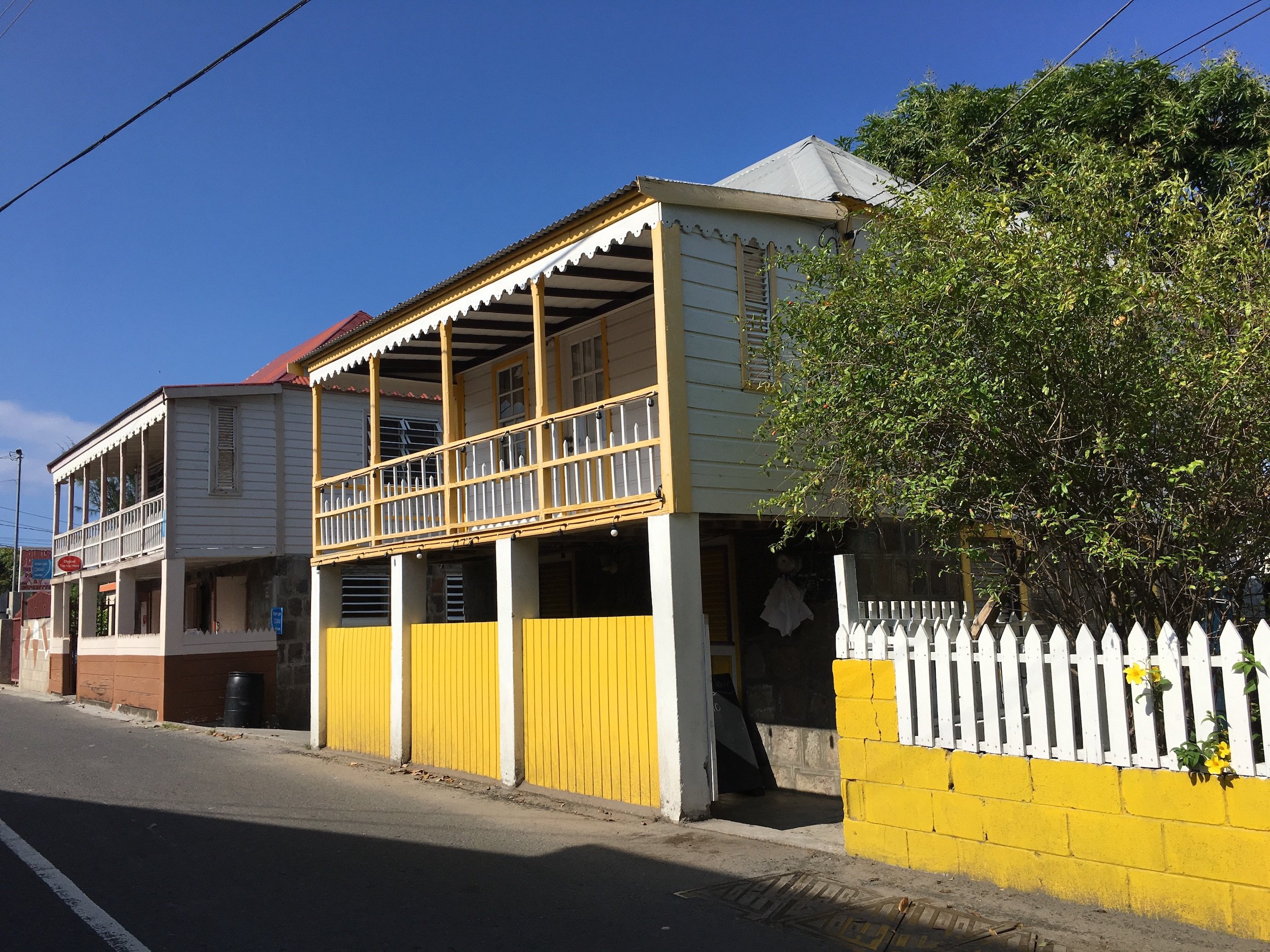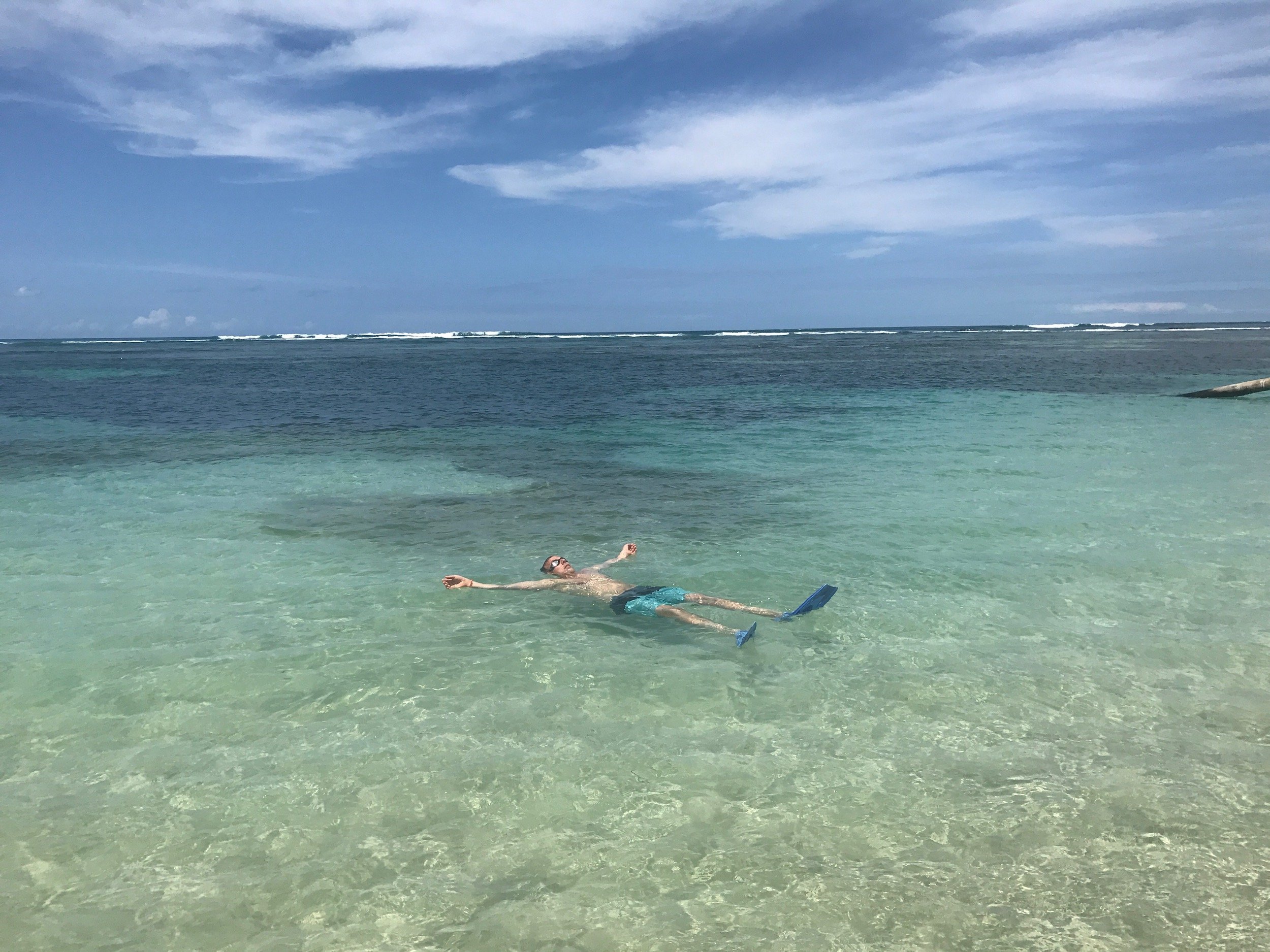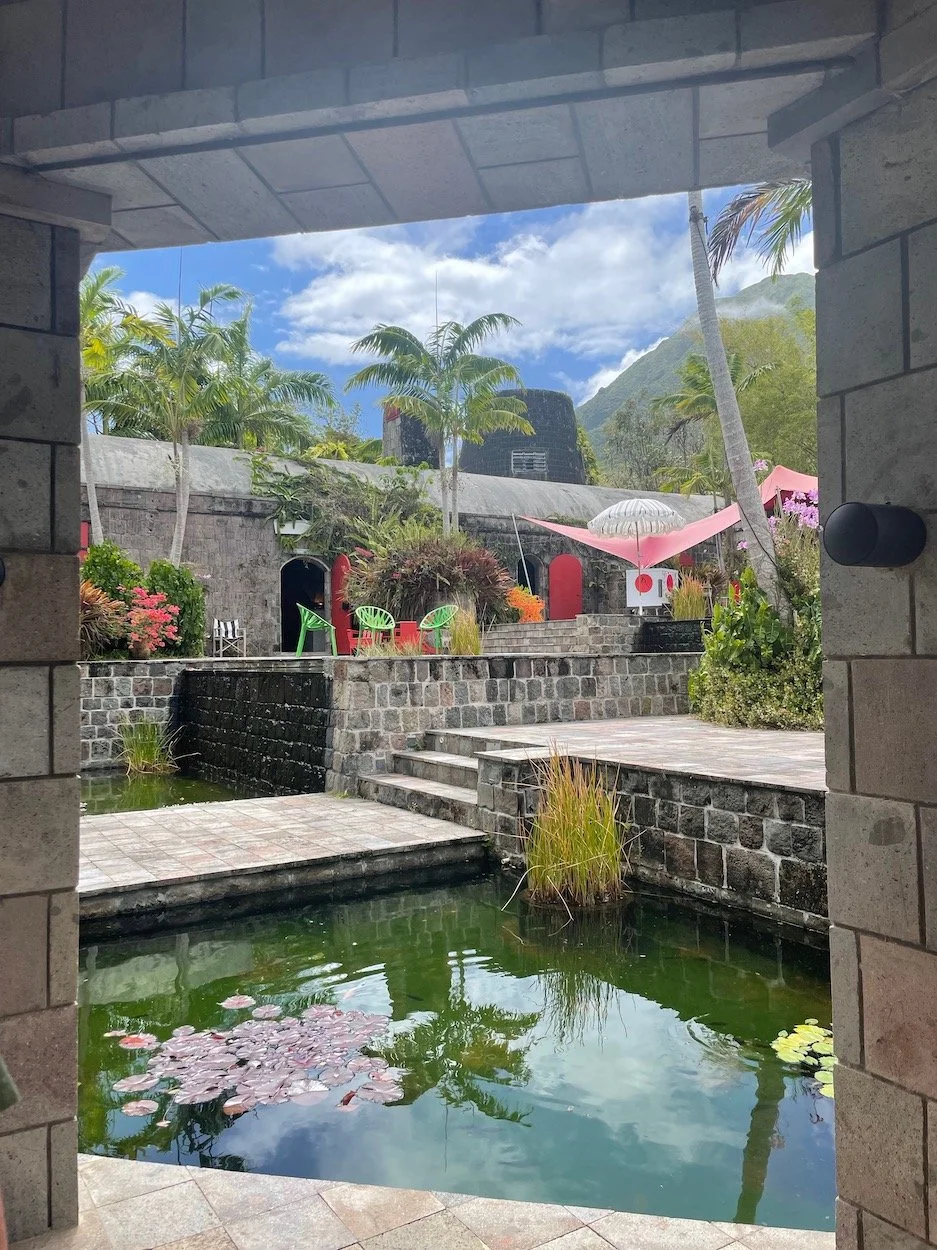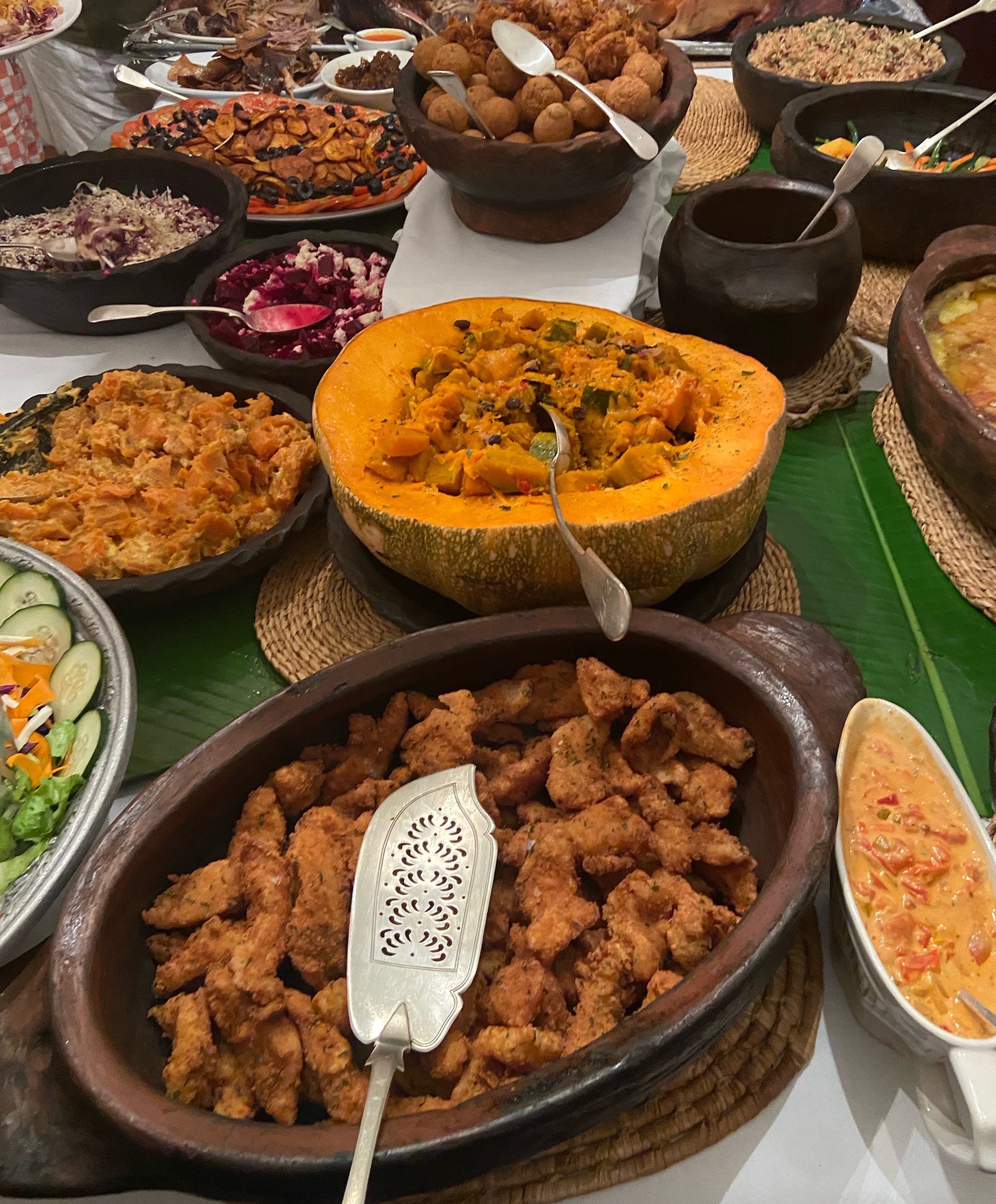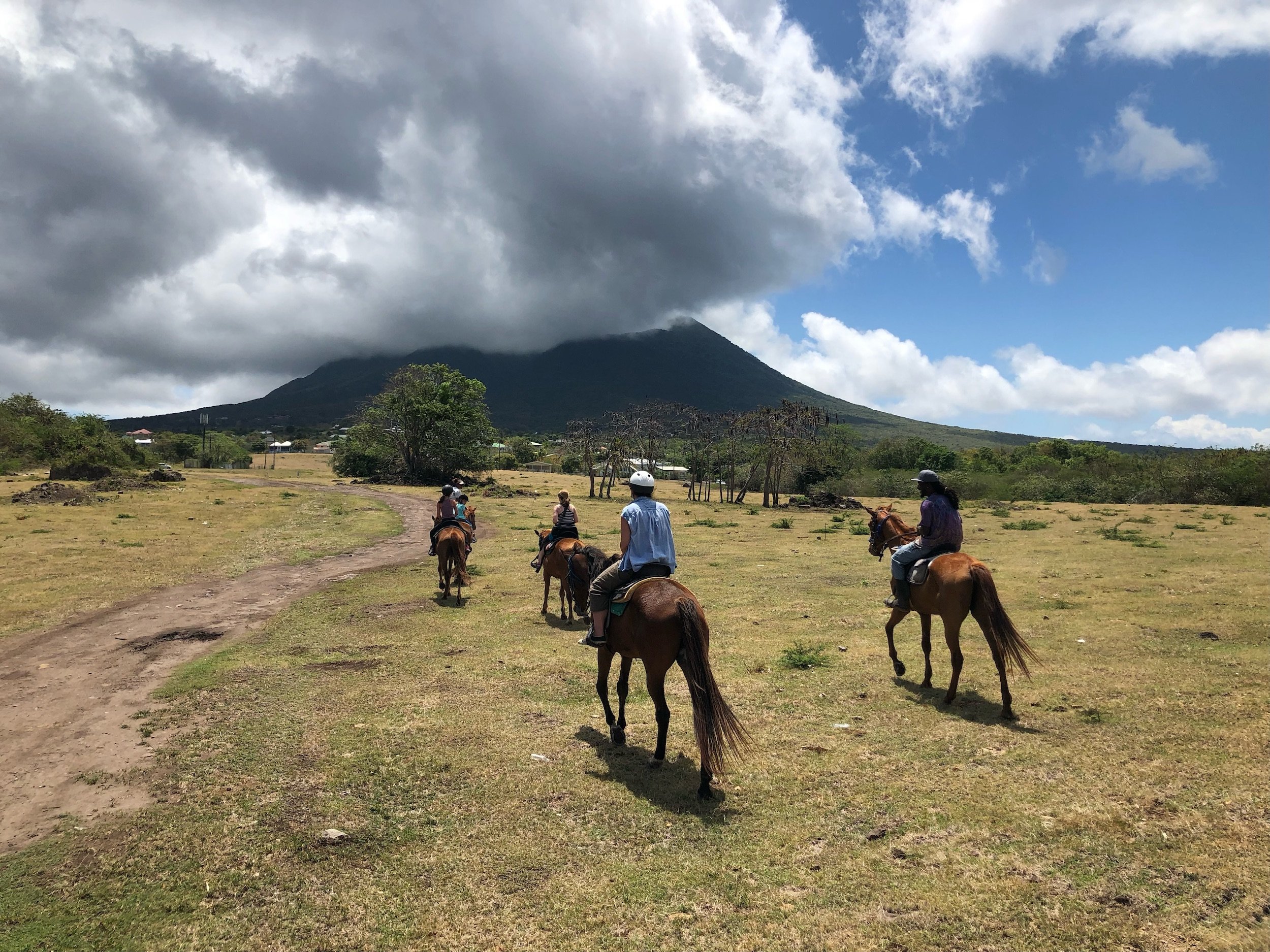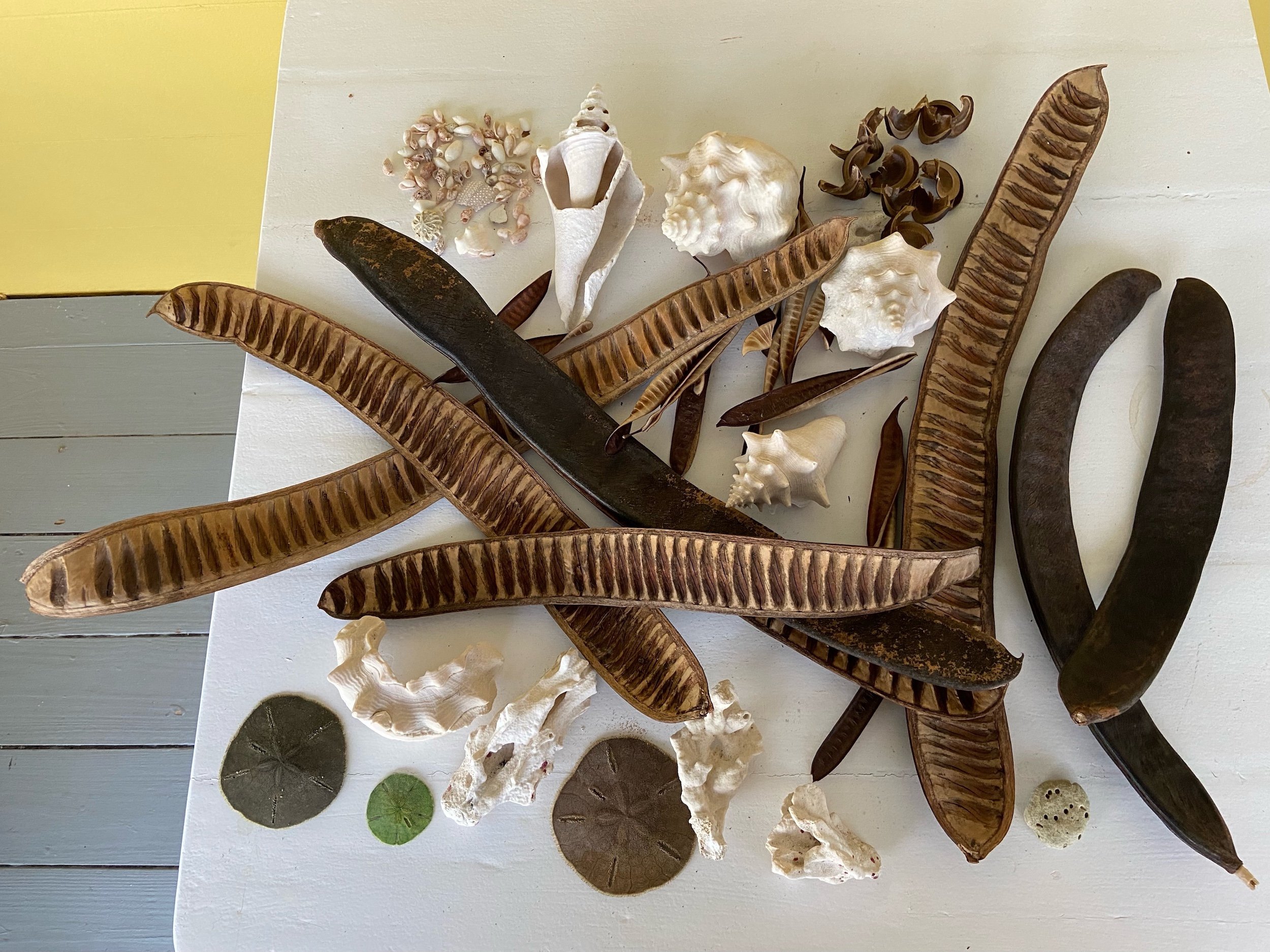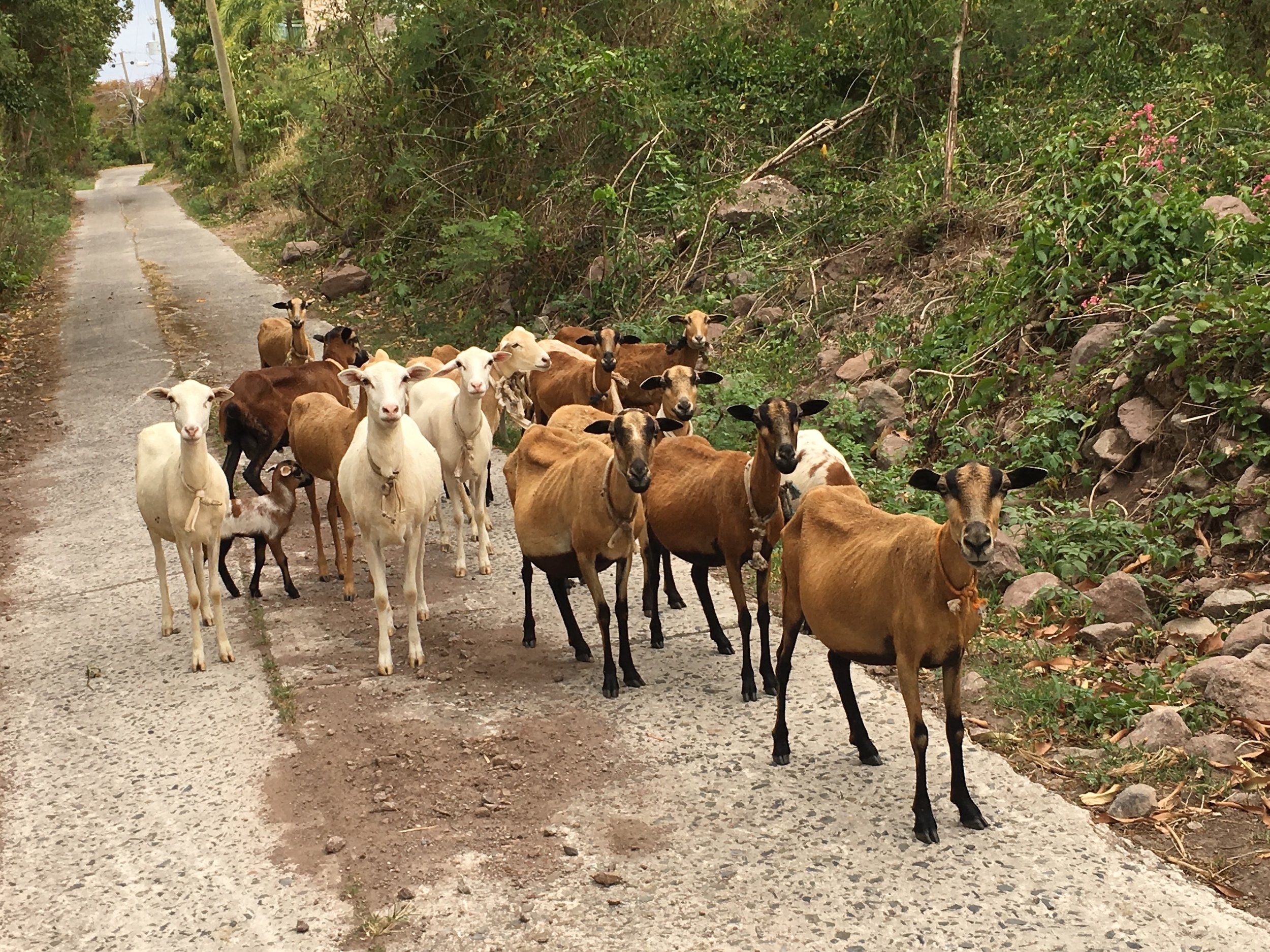Never Enough Nevis
At dusk on Nevis, as the breeze blows strong and steady and rustles the palms, the tree frogs begin their nocturnal serenade. Off in the distance, I hear roosters crow (yes, even at night), donkeys bray, dogs bark, and music.
One of my favorite things to do when we visit Nevis, the sister island to St. Kitts, is to simply sit on our terrace, gaze out over the forest down to the sea, and listen. The sounds that fill the air amaze and delight me every time.
On Sunday evening during our most recent visit, piano, drums and joyful voices singing “Hallelujah” rose up the hillside from a nearby church and mixed with the sounds of nature, creating the Nevisian symphony that I love. I sat with my rum punch and took it all in, marveling at this wondrous place that has become so special to my family.
When my daughter, Evie, was born in 2005, I planned to travel far and wide and show her the world. Now she is 18 and while we have been to Europe several times and traveled plenty domestically, much of our travel has centered on this one tiny, obscure Caribbean island.
I sometimes ask myself, why do we keep going back to Nevis—eleven times since Evie was a toddler—when I have a lengthy list of places we must see? The simple answer is that this sublime, unspoiled island captures our imaginations and hearts and endlessly fascinates us so that we cannot stay away for long. Each time we return and step foot on Nevis, we are overjoyed to be back.
No Towers. No Tourist Traps. Not Even a Traffic Light.
Late afternoon stroll on Paradise Beach. St. Kitts in the distance. Top photo: The Hermitage Inn.
Nevis is just two miles off the southeast coast of St. Kitts. But while they share a flag and government—the Federation of Saint Kitts and Nevis—the two islands are worlds apart.
St. Kitts has cruise ships, casinos, big hotels and trolleys filled with tourists. Nevis has none of the above. The island remains remarkably undeveloped and unpretentious. There’s not one chain store or restaurant, no buildings taller than a palm tree, no touristy gift shops and not a single traffic light on Nevis.
But while everyone seems to know St. Kitts, mention Nevis and you’ll likely get: “Where’s that?” “Never heard of it?” About the only thing some people know about Nevis is that Alexander Hamilton was born there.
Yet this little island was once a truly prominent point on the map. A few hundred years ago, Nevis was covered in sugar plantations that yielded great wealth for the British. Admiral Horatio Nelson married a Nevisian, Fanny Nisbet, on the island. The French, Dutch and English fought over the place.
Today some of those plantations have been converted into boutique hotels, while many others stand in majestic ruin. Drive around and you’ll see dilapidated sugar mills and other stone structures—most of them centuries old—beckoning modern explorers. Along the way, watch out for goats and sheep on the road, steer clear of donkeys, and keep your eyes peeled for monkeys. Lots and lots of monkeys.
For my family, the Nevis magic begins on the journey there. We fly into the small airport in St. Kitts’ capital, Basseterre, and take a taxi over the dramatic Southeast Peninsula to Reggae Beach, where a boat awaits to take us across The Narrows to Nevis. The crossing takes ten minutes and a driver greets us on the other side to transport us to our Nevisian “home.”
Our Place in Paradise
Since our first visit, in 2008, that home is the Hermitage, a charming inn built on a former plantation that dates to 1640. The Hermitage sits on the south side of Nevis, in Gingerland parish, at the foot of Nevis Peak, the 3,200-foot volcanic cone that dominates the island. The centerpiece of the inn is its great house, built around 1670 and believed to be the oldest surviving wooden house in the Caribbean.
The Hermitage Inn. The top floor “Loft” guest suite has a full-length balcony that looks out to sea. Part of the structure dates to the 18th century.
Richard and Maureen Lupinacci reclaimed this estate from the rain forest decades ago and developed the inn around it. It’s a breathtaking and magical place of traditional wooden “gingerbread” cottages spread across acres of gardens, lawns and magnificent palms. The dormant volcano towers above.
We always stay in the Loft—a large suite built atop a seventeenth-century stable with a broad terrace and sweeping views across the landscape, out to the sea. Most mornings we awake to cooing doves, gorgeous light streaming in through the shutters and a lovely breeze. Sometimes the roosters rouse us first, at 5 a.m. (luckily we fall back to sleep). Occasionally chattering monkeys or a piercing “eee-aw” from a nearby donkey gets me up and out early.
While the Hermitage is paradise for any type of traveler, it is truly a wonderland for children and perfect for families that want to spend time together. Our days start with a hearty breakfast out on the great house veranda. We watch brilliantly colored hummingbirds zip about as we enjoy coconut French toast, pumpkin pancakes or a spicy West Indian omelette with homemade sausage. Next, we generally hit the pool before we head out to explore.
Chicken Stone, Hardtimes, Burden Pasture, Brick Kiln
Passion Bar & Grill in Cox Village. Poor Man’s Bar in Rawlins.
The best way to see Nevis is to rent a car. We always get a crossover SUV, which is ideal for exploring the island. Driving on Nevis is not for the faint of heart. Roads are narrow. Passing can be precarious. Vehicles often park on the wrong side of the street, facing the wrong direction. Plus, folks drive on the left here, like in the UK.
Nevis is circled by one paved road, and a few other decent roads traverse the island here and there. Otherwise it’s a jumble of rough, dirt roads that run down to the beaches, up to villages and through the jungle. Most roads don’t have names posted; many dead end. On Nevis, I say: Go ahead; make that turn and see where it takes you.
Nevisian villages have fabulous names: Chicken Stone, Hardtimes, Zetlands, Burden Pasture. We like to pop into the little “superettes,” ”snackettes” and bars that dot the island. You find them in almost every village and along the main roads. There’s Poor Man’s Bar and Sweet Lips; Mel’s Bar and Little Bit Is Much.
One of our favorite stops is Double Scoop, a little ice cream shop and superette on the main road as you pass through the tiny village of Brick Kiln (blink and you’ll miss it), on the east side of the island. Over the years we’ve come to know the owner, Dalia, a sweet woman and diehard New York Yankees fan.
The village of Brick Kiln.
A few years ago, we stopped by over Easter weekend and Dalia gave us a delicious conkie she’d just made. Conkie is a traditional West Indian treat that, on Nevis and St. Kitts, is pretty much only eaten on Good Friday. Grated coconut, pumpkin and sweet potato, with a little sugar and spice, mashed together and wrapped, steamed and served in a banana leaf! Dalia shared a few secrets on cooking conkies and pointed out the little bird pepper bush in her backyard that gives her conkie its kick.
A Few Favorite Beaches
We stop in Brick Kiln as we curve up the island’s east side on our way to Herbert’s Beach. One of the wonderful things about Nevis is that nothing is far away. At 36 square miles, you can circle the island in an hour. We hop in the car, see how the spirit moves us and choose our beach for the day.
Like many beaches on Nevis, Herbert’s, at the northern tip of the island, is hidden and uncrowded, often with no one else around. You drive down a dirt road, past grazing cows, to get there. We pack up the cooler with fresh fruit and cold drinks, spread our blanket under a palm tree, and sink into tropical bliss.
Herbert's Beach is narrow with shallow, turquoise water. The snorkeling just off shore is pretty good. I saw sea urchins, conch shells and schools of small fish on our latest visit.
Floating with fins at Herbert’s Beach—a great place for some low-key snorkeling. I’ve seen some beautiful tropical fish here.
Paradise Beach, on the island’s west side, has a wide, sandy beach, a superb view of St. Kitts, great swimming and dazzling sunsets. Oualie Beach, ten minutes farther north, is the place to rent gear for water sports or to charter a boat. Oualie is one of the few beaches on a sheltered cove; the water is shallow and generally calm, ideal for kids.
As we drive around, we pull over at produce stands to buy pineapple and watermelon, exquisite Nevis tomatoes and baby bananas that we devour in minutes. We prefer the cute little stands, like Sherma’s and H&H Farms near the Hermitage, but we always make a point to stop at the big public market in Charlestown as well.
We bring our fruit and veggies back to the little kitchen in our Hermitage hideaway… make a salad, perhaps… slice up some fruit… and enjoy it on our terrace, with our spectacular view.
From Golden Rock to Goat Water
Nevis has three plantation inns—the Hermitage, Montpelier and Golden Rock—each with its own rich history and distinct personality and each worth exploring. We never leave Nevis without visiting Golden Rock—the entire property a must-see, stunning work of art.
The Golden Rock Inn.
Whereas the Hermitage is an enchanting village of wooden cottages with gingerbread trim and traditional decor, Golden Rock is a spectacular jungle retreat of imposing stone structures, dramatic gardens and modern design. Artists Brice and Helen Marden transformed a 200-year-old former sugar plantation into an utterly unique hideaway. No detail is overlooked—from the wildly modern furniture set within the old stone walls of the lounge (originally the plantation’s infirmary), to the extraordinary hue of vermilion that’s used as an accent color across the property, to the wrappers designed for the homemade ice cream bars.
Ice cream cart selling homemade ice cream bars in vibrant Golden Rock packaging.
Golden Rock’s restaurant, The Rocks, has a menu as sophisticated and satisfying as its surroundings. The conch chowder alone is reason enough to eat there. The green curry shrimp with coconut and lemongrass is also superb.
When it comes to eating out, Nevis has excellent options for its small size. A highlight for us, every visit, is the West Indian Feast at the Hermitage—or as we call it, the “pig roast.” It’s held most Wednesday nights and fills the great house with guests from across the island. The suckling pig roasts on a spit from morning ‘til dark and is then marched into the house, straight to the dining table, where it is carved and served with a magnificent spread of local dishes like cinnamon curried chick peas, tannia fritters, rabbit pie and braised short ribs. The meal is a festive affair, full of life, where travelers from around the world meet and mingle with Nevisians.
The magnificent West Indian Feast at The Hermitage features a whole roast pig served with an incredible spread of traditional Nevisian dishes.
When we want to be super laid-back, we chill at the beach bars on Pinney’s Beach. Our favorite spot is Double Deuce, which serves fantastic mahi mahi and burgers and, on Sundays, prepares roast beef and Yorkshire pudding to perfection. Double Deuce has a small swimming pool and a trampoline out back, a pool table, and weekly karaoke night. It’s a fun place.
Of course, some of the most authentic meals when traveling are what you buy on the street. On weekend evenings, across the island, Nevisians set up roadside barbecues. Last trip, I pulled over for some BBQ chicken and “cook-up” (rice with chicken and pigeon peas) and for the first time I tried goat water, a thick stew of goat meat (with lots of bones and fat), breadfruit and spices. I can’t say I Ioved it, but I’m glad I tried it. Our friend Joel, who left New York for Nevis thirty years ago, swears by the goat water at Ole House, a little restaurant just off the main road. I’ll try their version next visit.
Ruins All Around, Porcelain on the Ground
Nevis is tiny, but we never tire of the place or run out of things to do as a family. Over the years we have taken Evie to explore sugar mill ruins at the New River and Coconut Walk Estates, where you’ll find giant rusted machinery and a beautiful stone windmill.
We’ve hiked through the rain forest up steep grades, using ropes, to a series of small waterfalls. Our guide, Alfred Tyson, better known as “Baba,” pointed out native plants and described medicinal uses along the way.
On several trips, we chartered a sailboat from Nevis to St. Kitts. The boat anchored near a wrecked freighter in secluded Shitten Bay, where we snorkeled for awhile.
During our last two visits, we rode horses with Nevis Equestrian. Our guide, Erika, led us across fields, along trails, through villages, down to Paradise Beach where we rode along the water. It’s a fabulous way to experience the island.
Horseback riding excursion with Nevis Equestrian.
Nevis is rich with history and Charlestown, the capital city, has several important sites. When Evie was young, we took her to see the spot where the slave market once stood. We also visited Alexander Hamilton’s birthplace (a museum and reconstruction of his home) and the Jewish cemetery. Jews from Brazil came to Nevis during the island’s heyday to help with sugar production and nineteen tombstones remain visible in the little graveyard on Government Road. The oldest dates back to 1679.
As we explore Nevis, we love to take note of the names painted brightly across the front of the vans that provide bus and taxi service around the island. There’s Top Secret and Peculiar; Sir Daniel and Daddy Friday. They become familiar as the days go by. “Here comes Blue Berry Boy.” “Look, it’s Judges.” “Watch out, Shortie is about to stop!”
Nevis, thankfully, is not a souvenir shop sort of place. We favor the same two spots every visit to pick up a little something to bring back. In Charlestown, the philatelic bureau sells beautiful Nevisian stamps (Nevis and St. Kitts each issue their own) with images of butterflies, birds, all sorts of sea creatures and vernacular architecture. We frame them and hang them up at home.
At Newcastle Pottery, near Herbert’s Beach, Almena Cornelius makes traditional Nevisian red clay pottery. She hand-forms monkey lanterns, cooking vessels, large pots and small decorative objects in her studio and then fires them out back over burning coconut husks. The Hermitage serves much of the West Indian Feast in Newcastle clay cookware.
Handmade pots at Newcastle Pottery. Made from Nevesian red clay, then fired over burning coconut husks.
My favorite keepsakes are the little pieces of porcelain we find on the ground all over the island. Some locals tell me these fragments (I call them “china chips”) come from dinnerware and serving pieces discarded across the centuries. Others say it’s ballast from old ships.
I have found china on my morning runs up the road behind the Hermitage; behind the historic Bath Hotel, near the hot springs; even at the Jewish cemetery. Some pieces look remarkably old, others may date back just decades. One day all the lovely little shards of china we’ve collected over the years will make an incredible mosaic tabletop.
Nevisian treasures: porcelain pieces, seed pods, seashells, sand dollars.
Back Home at the Hermitage
Wherever we wander by day, we always arrive joyfully back up at the Hermitage. We return for a late day swim or a little tennis. We sit on our terrace with afternoon tea and carrot cake and watch troops of green vervet monkeys emerge from the forest to eat mangos and play. We read our books. Play Scrabble. Nap in a hammock. Paint in our journals. As much fun as we have at the beach, many of our best memories are right here.
We first brought Evie to the Hermitage in a stroller and she slept in a crib draped with mosquito netting. Now she knows her way around every inch of the property and has her favorite spots across the island. Evie has grown up with, and grown to love, this fascinating speck of land in the sea.
I have come to accept that we won’t see even a fraction of the destinations on my lengthy list with my daughter. But there is much to be said for returning to the same faraway place year after year as a family and truly getting to know it deeply; to understand and appreciate it; to befriend the people there.
Years ago, when we were visiting with Dalia at Double Scoop, I told her how much we love her island and how often we visit. She smiled and said, “Ah. You are American Nevisian!”
And I thought to myself: Yes. Exactly.
“You lookin’ at me?” Stare down with some sheep on Nevis.
NEVIS GUIDE
STAY
The three historic plantation inns are inland, but just a short drive to the beach. Nevis is a tiny island. All three have pools, and you can still get plenty of beach time whenever you’d like. Staying at these beautiful properties, amidst the gardens and wildlife, is a unique experience.
The Hermitage—An enchanting hideaway at the foot of Nevis Peak. Historic great house and charming guest cottages with traditional gingerbread trim and Caribbean decor across acres of lawns and gardens. Friendly, welcoming, wonderful, memorable.
Golden Rock Inn—Former sugar plantation, now a stunning boutique inn, with extraordinary gardens and landscaping. Dramatic setting and fantastic modern art and decor.
Montpelier Plantation & Beach—Exquisite escape in the foothills of Nevis Peak. Perhaps the most luxurious of the plantation inns on the island. Princess Diana and Fergie holidayed here.
Oualie Beach Resort—Small beachside cottages. Nothing fancy, very laid back vibe. The most affordable and casual of the accommodations listed here.
EATS
At The Beach / By The Sea
Turtle Time Beach Bar & Grill—Beach bar on Pinney’s Beach. Menu includes nice selection of tasty stir fry and other Asian dishes.
Lime Beach Bar—Beach bar on Pinney’s Beach. Cabanas available by the water.
Sunshine’s Bar & Grill—Legendary beach bar at Pinney’s Beach. Famous for its potent rum punch, The Killer Bee.
Barefoot Beach Bar—Sushi rolls and more, on the beach, at Nelson Spring Villas.
Drift—Lovely place at the water’s edge on the Atlantic side of the island, with a view of St. Kitts. An inspired, sophisticated menu. Great cocktails, too.
Yachtsman Grill—Beachfront dining. View of St. Kitts. Dazzling sunsets. Enjoy the beach and a swim while you’re there. Seafood, steak, pizza, too. Located at The Hamilton Beach Villas & Spa.
In The Hills
The Hermitage—Fine dining on the veranda each evening. Wonderful breakfasts. Lunch, too (try the roti). Friday is “pizza night” with outstanding wood-fired pizza. Wednesday night is the not-to-be-missed West Indian Feast (see below).
“The Rocks” at Golden Rock—Remarkable setting, exceptional food. Gaze out at the sea, across the magnificent landscaping, as you enjoy your meal. Breakfast, lunch and dinner.
Montpelier—Fine dining at Restaurant 750. Casual lunch and dinner at Indigo. An intimate candlelit dinner in a 300-year-old sugar mill at Mill Privée.
Bananas—A whimsical bistro, up in the hills, with a view out to sea. Eclectic character and decor, lush gardens, inventive Caribbean/Mediterranean-inspired cuisine, outstanding selection of aged rums. Come for a cocktail and watch the sunset.
In Charlestown
The Cafe des Arts—By the ferry pier and next to the Museum of Nevis History. Cute, casual cafe serves breakfast all day. Tuesday is burger night.
Slack's Tastee Jamaican Bakery—Bare bones inside, but the baked goods are scrumptious. We always pop in for a sweet treat when in Charlestown. Located at the parking lot, right by the pier.
Authentically Nevisian
West Indian Feast at The Hermitage—We call it the “pig roast” and it’s a family favorite evening every time we visit Nevis. Succulent pork, roasted on-site on a spit all day long, served in the great house dining room with an incredible variety of traditional West Indian dishes. Always a memorable, delicious, joyful, social gathering. Arrive early for a pre-feast rum punch!
Ole House Cafe—Traditional Nevisian fare. Order at the counter. Local place, nothing fancy—but always tasty and staff is super nice. We go for lunch.
Passion Bar & Grill—Off the beaten path, in Cox Village, charming, colorful, local spot with wonderful home cooking and loads of character. Close to Montpelier Inn. Very “Nevis!”
“Cook-up”—On weekend evenings, you’ll pass roadside BBQs set up by Nevisians all over the island. Pull over and grab some grilled chicken, rice and peas, and veggies to-go. About as authentic as you can get.
A Break from Island Fare
Indian Summer—Top-notch Indian cuisine. Located by Nelson Spring Beach Villas.
BEACHES
All Nevis beaches are public. There are no “private” beaches at all. Even if a resort or restaurant occupies the beachfront property, you are welcome to enjoy the beach and water anywhere. Also, keep in mind that many beaches are secluded and have no public restroom/changing/food facilities.
Pinney’s Beach—The main beach on Nevis, on the Caribbean side of the island. Generally calm seas, soft sand, good swimming—with fantastic views of St. Kitts and great sunsets. Pinney’s starts just north of Charlestown and runs several miles up the shore. Many of the best beach bars are here, as well as The Four Seasons Resort and other properties. The beach is wide and never feels crowded, however.
Paradise Beach—Our favorite Caribbean beach on Nevis. Drive down the dirt road at St. Thomas Primary School (watch out for grazing cattle). There’s a stretch of beach here backed by forest, with no developed property. The sandy shore slopes gently into the gorgeous water. Great swimming. A quiet spot.
Herbert’s Beach—Another favorite. On the Atlantic, so the water is rougher than the Caribbean beaches (it gets quite windy over here). Narrow and not as soft and sandy as Paradise. Dramatic feel, good snorkeling—and a good place to find conch shells. Often we’re alone here. Drive down the long dirt road by Nisbet Plantation in Newcastle.
Indian Castle Beach (aka Windward Beach)—One of the more remote beaches. Not ideal for swimming. Surf can get rough. On the southeast side of the island (Atlantic Ocean).
Lovers Beach—Secluded, romantic, on north end of island, with view of St. Kitts.
Oualie Beach—Great beach for little kids. Generally very calm and the only beach with a roped off swimming area. Located at the Oualie Beach Resort. You can rent water sports equipment here and bikes, too. Food and drink available at the beachside restaurant.
SIGHTS
Historic
Jewish Cemetery—Jewish graves dating to the 17th and 18th centuries, when Nevis had a thriving Jewish population of planters from Brazil. In Charlestown.
Slave Market site—The spot where thousands of slaves were sold to plantation owners, starting in the 17th century. There is a historical marker here now, but little else. A powerful, poignant site and a place to seriously think about the island’s history. In Charlestown.
Museum of Nevis History / Alexander Hamilton Birthplace—Great little museum and bookstore on the site of Hamilton’s birthplace. In Charlestown, by the ferry pier.
Bath Hotel and Nelson Hot Springs—The Bath Hotel was the first resort hotel in the Caribbean. (The building currently houses government offices.) The hot springs, just downhill from the hotel, are a little worse for wear and neglect across the years, but they’re still open for a soothing, hot soak. The spring facility is not fancy and it’s definitely not for everyone. No charge. No reservation required. Rarely crowded.
St. Thomas Lowland Church—Nevis’s oldest church, built in 1643. Beautiful stone structure on a hilltop with a stunning view out to sea. Walk through the old cemetery as well.
Ruins/Estates
New River and Coconut Walk Estates—A favorite hike, past sugar mill ruins and old machinery, down to the stone lime kiln remains by the sea.
Cottle Church—Earthquakes and hurricanes have taken their toll, but the ruins of this 200 year old church still stand. Quite a sight.
ACTIVITIES
Nevis Equestrian—Wonderful guided rides for all levels. One of the best ways to see Nevis is on horseback as you trot through villages, across pastures, down dirt roads, and along the beach. Lessons offered, too.
Bike Nevis — Bike rentals and bike tours. Based at Oualie Beach.
Dive Nevis—Scuba and snorkel excursions. Dive courses. Deep-sea fishing. Based at Oualie Beach.
Nevis Aquatic and Sailing Center—Sailing classes, boat rentals (sailboats, kayaks, paddle boards) and more. Based at Oualie Beach.
SHOP
Newcastle pottery—Traditional Nevisian red clay pottery. Everything is hand-built and fired in back of the studio on a pile of burning coconut husks and palm fronds. During your stay on Nevis, you’ll likely see Newcastle cookware, flowerpots, and fixtures all over the island. (We have numerous monkey lanterns and serving pieces at home.) Truly wonderful items. The studio is right on the island’s main road, across from Nisbet Plantation Beach Club.
Nevis Philatelic Bureau—Purchase Nevisian stamps with images of native flora and fauna, vernacular architecture, and historical figures. They are colorful, beautiful and unusual. I buy them to frame and hang on the wall. Of course, you can buy stamps and postcards here to write home as well! On Market Street, Charlestown.
Nevisian Artisan Village—Colorful cottages where artisans sell their crafts and souvenirs.
The Indigo Egret—A superbly curated selection of art, jewelry, decorative objects, home decor, glassware, gifts, and more. Local and imported items. At Riviere House in Charlestown.
The Arthouse at Hermitage—Bright and cheerful boutique at The Hermitage where you will find beachwear in beautiful fabrics, books, art, and jewelry. Sister shop to Indigo Blue. Call ahead to check boutique hours.
There is not a lot of shopping on Nevis. The Arthouse and Indigo Blue are two of your best bets for special finds that you’ll want to take home with you.






